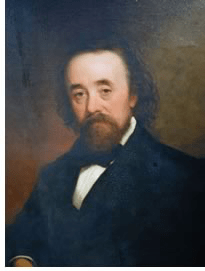Richard Upjohn facts for kids
Quick facts for kids
Richard Upjohn
|
|
|---|---|

Upjohn oil portrait circa 1870
|
|
| Born | 22 January 1802 Shaftesbury, England, UK
|
| Died | 16 August 1878 (aged 76) |
| Nationality | British |
| Occupation | Architect |
| Buildings | William Rotch Jr. House Oaklands Kingscote Church of the Ascension Edward King House St. Paul's Cathedral Hamilton Hoppin House Kenworthy Hall |
| Projects | Trinity Church Church of the Holy Communion Lindenwald Green-Wood Cemetery Gate |
Richard Upjohn (born January 22, 1802 – died August 16, 1878) was a famous British architect. He moved to the United States and became best known for designing churches in the Gothic Revival style. He helped make this style very popular in America.
Upjohn also worked a lot with the Italianate style, helping it become well-known too. He was one of the people who started the American Institute of Architects (AIA). He was also its very first president! His son, Richard Michell Upjohn, also became a famous architect. He worked with his father in their architecture firm in New York.
Contents
Richard Upjohn's Life and Work
Richard Upjohn was born in Shaftesbury, England. He learned how to build and make cabinets. He became very skilled in these areas. In 1829, he and his family moved to the United States.
They first lived in New Bedford, Massachusetts. Then, in 1833, they moved to Boston. There, Upjohn started working on architectural designs. He became a citizen of the United States in 1836.
His first big project was designing the entrances for the Boston Common. This is a large park in the center of Boston. His first church design was for St. John's Episcopal Church in Bangor, Maine.
By 1839, Upjohn had moved to New York City. He began working on changes to the famous Trinity Church on Wall Street. Later, instead of just changing it, he was asked to design a whole new church. This new Trinity Church was finished in 1846. You can still see it today!
In 1852, Upjohn published a very important book. It was called "Upjohn's rural architecture: Designs, working drawings and specifications for a wooden church, and other rural structures". The designs in this book were used by builders all over the country. Many buildings based on his designs are still standing.
Founding the American Institute of Architects
On February 23, 1857, Richard Upjohn and 13 other architects started the American Institute of Architects (AIA). He was the president of the AIA from 1857 to 1876. After him, Thomas Ustick Walter took over.
Upjohn designed many buildings in different styles. He passed away at his home in Garrison, New York in 1878.
Famous Buildings by Richard Upjohn
Richard Upjohn designed many important buildings. Here are some of his most well-known projects:
Churches Designed by Upjohn
- Trinity Church in New York City, (1839–46)
- The Church of the Ascension in New York City, (1840–41)
- Grace Church in Providence, Rhode Island, (1845)
- Christ Episcopal Church in Raleigh, North Carolina, (1846–48)
- St. Paul's Cathedral in Buffalo, New York, (1849–51)
- Old St. Paul's Episcopal Church in Baltimore, Maryland, (1854)
- St. Peter's Episcopal Church in Albany, New York, (1859)
- Church of the Covenant in Boston, Massachusetts, (1865–1867)
- St. Mark's Cathedral in Salt Lake City, Utah, (1870)
- Trinity Church in Princeton, New Jersey, (1870)
Homes Designed by Upjohn
- William Rotch Jr. House in New Bedford, Massachusetts, (1834)
- Kingscote in Newport, Rhode Island, (1839)
- Edward King House in Newport, Rhode Island, (1845–47)
- Lindenwald in Kinderhook, New York, (1849)
- Kenworthy Hall in Marion, Alabama, (1858–60)
Other Buildings by Upjohn
- Abiel Smith School in Boston, Massachusetts, (1835)
- Bristol Academy in Taunton, Massachusetts, (1852)
- Dorchester County Courthouse and Jail in Cambridge, Maryland, (1853)
- Corn Exchange Bank in New York, New York (1854)
- Edwin A. Stevens Hall in Hoboken, New Jersey, (1870)
- North Gate Screen (1860s) and the Pierrepont family tomb (around 1860) in Green-Wood Cemetery, Brooklyn, New York
Images for kids
-
William Rotch Jr. House, New Bedford, MA, (1834)
-
Trinity Church, New York City, (1839–46)
-
Kingscote, Newport, RI, (1839)
-
Bowdoin College Chapel, Brunswick, ME, (1844-1855)
-
Church of the Holy Cross, Middletown, RI, (1844)
-
Grace Church, Providence, RI, (1845)
-
Edward King House, Newport, RI, (1845-47)
-
Old St. Paul's Church, Baltimore, (1854)
-
Kenworthy Hall, Perry County, AL, (1858–60)
-
St. Peter's Episcopal Church, Albany, NY, (1859–60)
-
All Saint's Memorial Church, Navesink, NJ, (1863–64)
-
Church of the Covenant, Boston, (1865–67)
-
Trinity Episcopal Church, Litchfield, MN, (1871, attributed)















